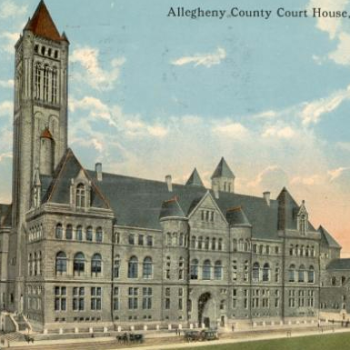There is no agreed upon definition of mass murder, with differences arising over a threshold number of victims, the length of time between killings, and the location(s) of the killings. Rather than making a series of narrow distinctions between mass murder, spree murder, and rampage murder, I define mass murder as the murder of three of more people as part of a continuous event.
By that definition, there have been five mass murderers who have been sentenced to death in Allegheny County history.
Ernest Ortwein, who lived and worked on the Hamnett farm, killed John and Agnes Hamnett, their children, Ida and Emma, and Robert Smith, a boy who lived and worked on their farm near Homestead, on April 29, 1874. Whether his motive was robbery – John was a prosperous farmer rumored to have a large amount of cash – or rape – there was some suggestion Ortwein raped Ida and then killed her and the others to conceal his crime – was never clearly established. He was executed on February 23, 1875.
In perhaps the most improbable and disturbing of the 201 death penalty cases in Allegheny County history, Martin Sullivan, a Duquesne police officer charged with raping a child, killed the parents of another girl he had raped, the mother and brother of the girl whose rape he had been charged with, and the social worker who had investigated the rape, all while in police custody, on December 17, 1936.
The three other mass murders that have resulted in a capital conviction all occurred in this century and had explicitly racial motivations.
Ronald Taylor, a Black man who harbored deeply felt racial grievances, set off on March 1, 2000, to kill white people. His first victim was his apartment maintenance man, who Taylor believed had not made a repair he needed. He then shot and killed two people at a nearby fast food restaurant and shot and injured two others. After barricading himself in an office building, he surrendered to police. He remains on death row.
Less than two months later, on April 28, 2000, white supremacist and anti-immigrant extremist Richard Baumhammers, killed five people, his Jewish neighbor, an Indian man, two Vietnamese men, and a Black man, as he moved methodically across the southern and western suburbs of Pittsburgh. He also remains on death row.
Richard Poplawski, also an avowed white supremacist, lived with his mother in Stanton Heights. When she called the police to have him removed from her home on April 4, 2009, he armed himself and waited. He shot and killed the first two officers who arrived and then a third officer who was off-duty but in the area and responded to the scene. He was arrested after a four-hour standoff with police, during which three other officers were shot and injured. Poplawski also remains on death row.
An untold number of other mass murders have occurred but have not resulted in the imposition of a death sentence. Some cases, such as the 2009 LA Fitness murder of three women by a violent incel, George Sodini, ended in the death of the shooter.
In others, such as the 2016 mass murder of six at a Wilkinsburg house party, the killer was either never apprehended or convicted.
In the most recent and worst mass shooting in the county’s history, the 2018 anti-Semitic Tree of Life shooting that killed eleven, federal charges against Robert G. Bowers, which may result in a capital conviction, are pending.
